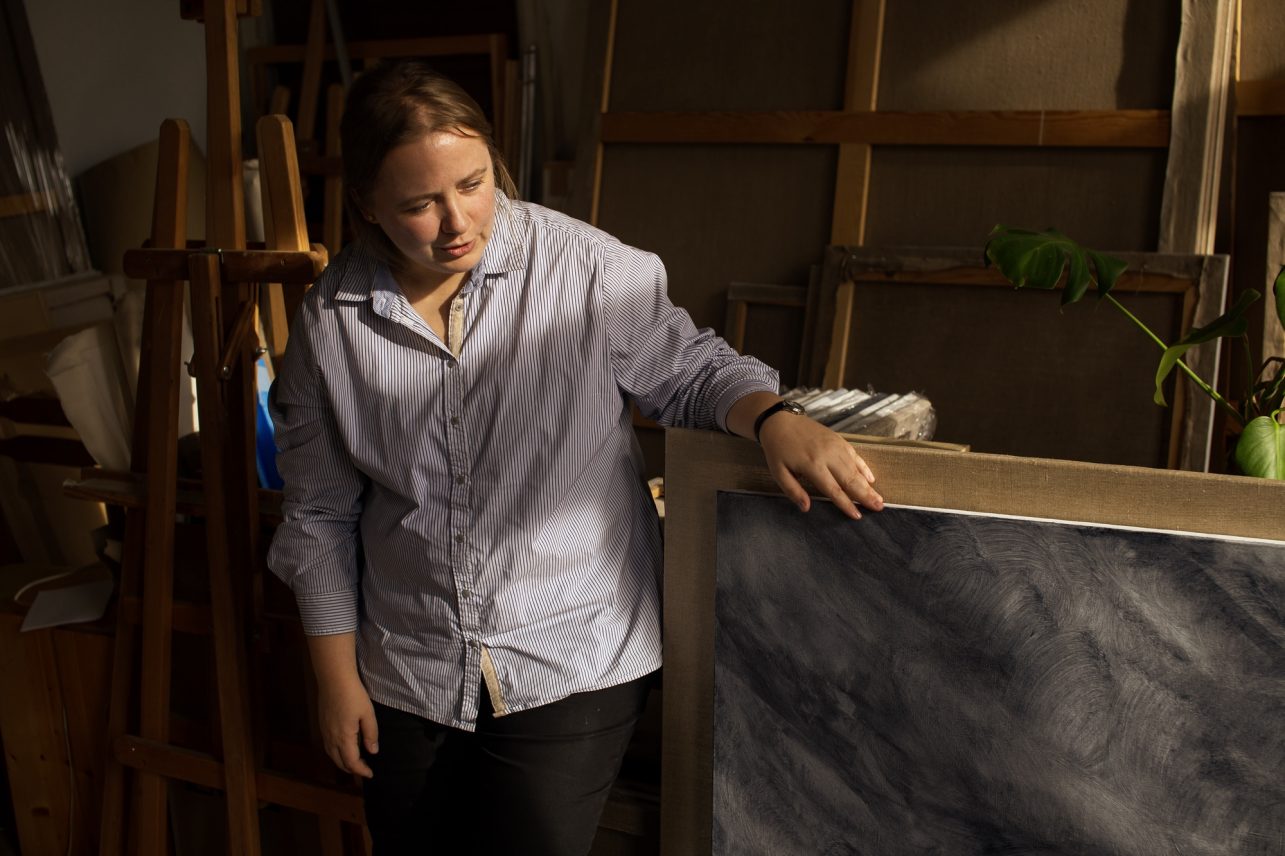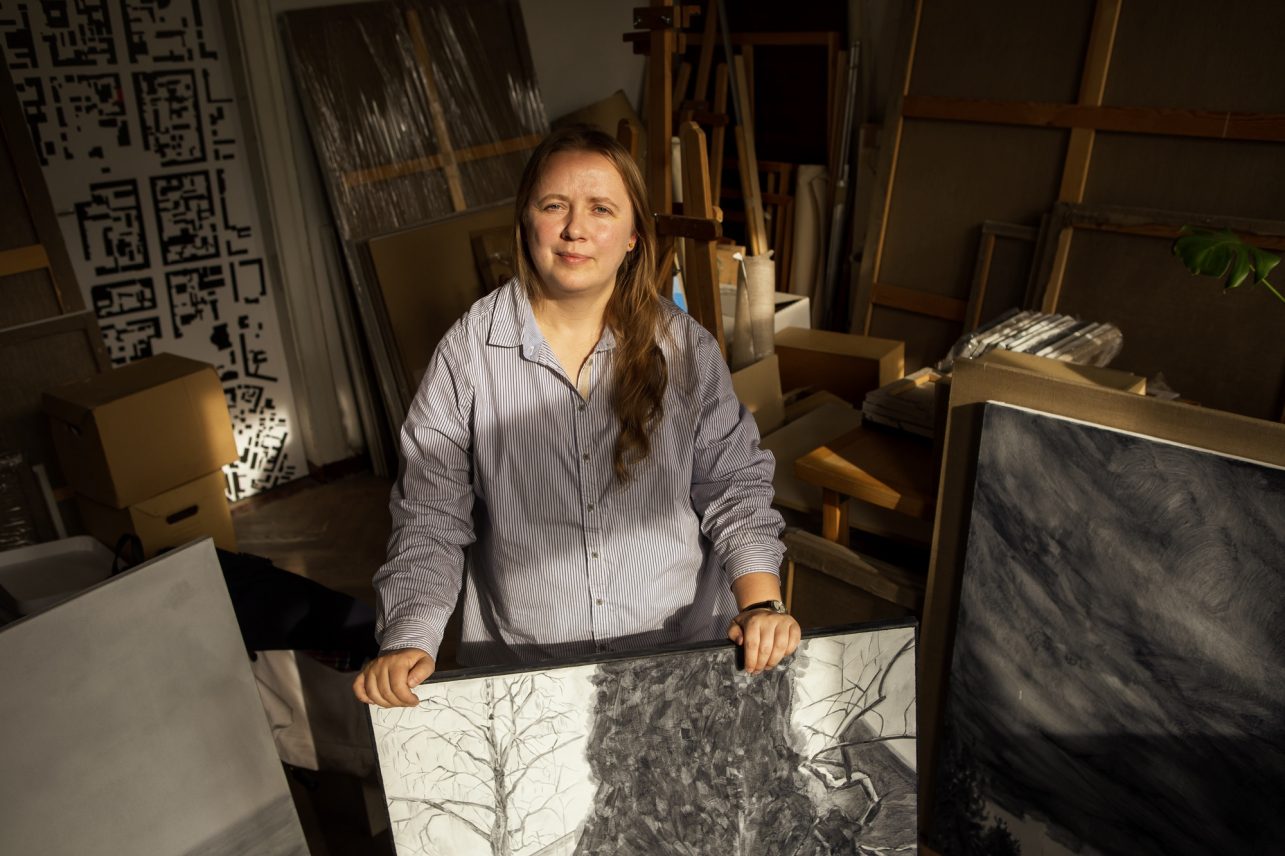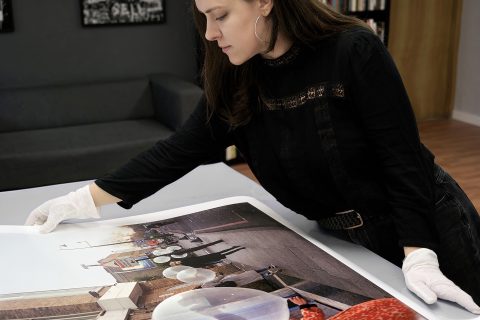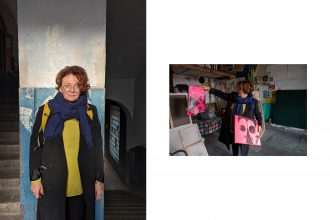Have you ever wondered what colour Kaunas is? Žaliakalnis, Šančiai, Dainava or Šilainiai? Or maybe even the village of your grandparents where you spent your childhood summers? I, personally, haven’t. However, this autumn I began to look at the elements of my environment much more carefully. I notice the pink colour that appears in the old town at the Nemunas and the Neris confluence and the grayness that prevails in Independence Square around the Church of St. Michael the Archangel. These thoughts were caused by meeting Milda Gailiūtė, who is more of a teacher during the day, and more of an artist in the evenings and on weekends.
“In the mornings, I work as an art teacher in a kindergarten in Kaunas, and in the afternoons, I conduct private art lessons for children of various ages. I usually return to creative work on weekends or evenings when I am done with all other work,” Milda says. Eleven years ago, the artist qualified as a teacher, and she is very happy about it – working with children really helps creativity, and a small amount of time in the evenings helps her concentrate more on her creative ideas. She also remembers that she really liked to draw and paint from an early age and was happy that her teachers constantly encouraged her not to stop, to improve, and to develop this hobby.

Encouraged by a teacher, Milda started attending the A. Martinaitis Art School. After finishing it, it seemed natural to continue studying art, so she entered the Vilnius Academy of Arts Kaunas Faculty where she got her bachelor’s and master’s degrees. “The path of an artist was my dream. As a child, I always thought that I wanted to be an artist when I grew up. So, my dream has come true,” Kaunas local says. She never tried to find out where that desire came from. There was one famous sculptor in the family, both grandmothers wove and sewed beautifully, but she doesn’t know if that is related in any way. Perhaps the most important thing is that creativity has been close to her heart since childhood.
Creation requires a little tension, a firm decision and an understanding of what and why you want to paint
When talking about what her regular day looks like, Milda mentioned that she thinks about creation every day, and writes a lot, but there are also weeks and months when she does not even touch the canvas. She gets in this state, especially after solo exhibitions that require high concentration and a lot of painting as a physical activity. A specific deadline by which something needs to be written or painted is a good incentive. Otherwise, when you have a lot of time on your hands and are in no hurry, the paintings may look too tortured and lifeless.
Deciding what to create is not difficult – there is a list of photos and ideas on the computer waiting to be finally painted. “And focusing on something really helps – sometimes I can paint a lot in one session. You may not paint for a while after that, but eventually, you start thinking about new themes and motifs again and go back to work soon after. Sometimes, I take up painting more consistently. In autumn and winter evenings, I go to the studio with the task of painting small-format works, in order to stay in a sort of painterly shape – just like in sports, where you must maintain your skills. This is how a part of the Miegamasis mikrorajonas (sleeping microdistrict) series appeared. I painted my native Kaunas microdistrict of Šilainiai, where I lived from six to twenty-nine years old. I do not paint every day; I don’t have such a routine. Creation requires a little tension, a firm decision and an understanding of what and why you want to paint,” the artist says.

“In the beginning, I painted Šilainiai in small formats, then I switched to larger ones: I painted the gray sky above Šilainiai. After the quarantine, I started painting the outskirts of the city that I liked to visit or the landscapes of Kaunas Lagoon. Žaliakalnis, to which I moved from Šilainiai, is also an important topic among other motifs of Kaunas. Some of Žemieji Šančiai also ended up in my paintings because the kindergarten I work at is located there. I’m always looking for relevant motifs and I often turn to everyday life motifs that I might have seen or captured recently, a few days before painting in the studio,” the painter continues.
She likes to observe the city changing and notice the nature in it. Since the fall of 2008, Milda has given up deep, rich colour painting and uses one colour to capture everything. “In the second year of my master’s studies, it was time to focus on final works. I had just returned from a plein air in Žagarė. I was painting abandoned buildings and I finally realized that, when it comes to the history of the town, those usual colours are not suitable. So, I found a wallpaper from Žagarė plein air and a similar colour of oil paint and started painting in one colour. I was wondering how one can paint using only one colour and what the possibilities were. Then I painted with that one colour for about four years.” the interviewee opens up.
Everything is very simple: the artist likes fewer colours. She likes minimalism when you can concentrate on the idea and forms. This is how at some point a colour was dedicated to Kaunas. “I thought about it for about three years. In 2015, in Žaliakalnis, during the plein air, after a long search, I dedicated a colour to Kaunas. However, gray turned out to be the most neutral here, and the oil paint suited very well. In painting, you can obtain a wide range: from the lightest hues to the darkest black. And that gray paint for me is the colour of everyday life, which I associated with life in Kaunas,” she added.
Kaunas is gray, Žagarė is closer to bluish, and Austria’s Vienna, where the artist participated in the artists’ residency program in 2012, has a yellowish shade. It turns out that Milda went to Vienna without any paint or brushes – she wanted to see how the city itself would inspire her. Eventually, she dedicated yellow to that city and painted a whole series of works in 2012 – 2014. After finishing it, the artist realized that it was enough to paint the places she visited temporarily; it was time to turn to the ones close to her. That is how she started working on the series about her childhood village. The artist chose the pink colour of old, slightly discoloured photos.

“When I paint, I rely on photographs. Photography is a way to return to a specific place at any time, to remember a specific mood. It’s like I’m creating a story, a narrative with my works. For example, when creating the Vienna series, I painted these little houses because it was my very first impression when I arrived at a residence in the suburbs. Returning to this series in the studio in 2014, I painted larger-format landscapes and the people I met there. When thinking about Kaunas, you should delve into my first series of paintings about Kaunas – Sleeping Microdistrict – where the main idea of the colour palette is revealed perfectly. Everyone said that Šilainiai is gray and gloomy without any vegetation, but I thought the exact opposite. Therefore, in those works where there is asphalt or some kind of building, I don’t paint anything and leave the canvas blank, I only focus on this microdistrict’s nature,” Milda says.
In her works, the artist turns to the motifs of the city and observes and captures the changing image of Kaunas and its suburbs in her everyday life. She continues her work with the gray colour dedicated to Kaunas. The artist is preparing for a new solo exhibition about Kaunas, which will be opened in January next year in the art gallery of the Kaunas branch of the Lithuanian Artists’ Association located in the Drobė factory. That is where you will be able to see how Milda sees Kaunas now.




